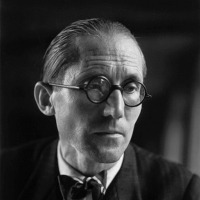A central theme of this exhibition is Le Corbusier’s oscillation between two seemingly disparate pursuits: his celebration of mechanical objects and his search for poetic forms. The exhibition will highlight the way in which this complex relationship developed from his youthful study trips around Europe to his late work, investigating the resonances between artistic work and architectural design. At the centre of attention for this migration of themes is Le Corbusier’s painting studio – his “secret laboratory”.
The exhibition is organised in five thematic sections dealing with the major stages of his work: his purist paintings and the villas of the 1920s; his rediscovery of vernacular values in the 1930s; his preoccupation with the synthesis of the arts after 1945; and the complex reminiscences of his late work. Moreover, special attention will be dedicated to Le Corbusier’s relationship to Sweden. His plan for the urbanisation of Stockholm (1933) and the museum he designed for the Ahrenberg collection (1962) will be juxtaposed with comparable plans and projects.
The exhibition assembles a diverse body of material, in terms of both medium and scale. The 200 works selected include paintings, landscape drawings, still-lifes, portraits, sculpture, tapestries, furniture, architectural drawings, models of buildings and of entire city plans, books, and photographs.
Le Corbusier: The Secret Laboratory is curated by Jean-Louis Cohen, professor at New York University, and a prolific author of books on Le Corbusier. Cohen conceived the centennial Le Corbusier exhibition at the Centre Pompidou, and is preparing Le Corbusier, Landscapes for the Machine Age, scheduled to open in June 2013 at the Museum of Modern Art in New York. The associate curator is Pascal Mory, author of several important architectural exhibitions, including Towers and Skyscrapers, from Babel to Dubai, currently on show at the CaixaForum in Madrid.
Le Corbusier: The Secret Laboratory is organised in association with the Le Corbusier Foundation, with important contributions from the AVC Charity Foundation.
Curators are Jean-Louis Cohen och Pascal Mory.
Venue.- Moderna Museet. Skeppsholmen, an island in central Stockholm. Sweden.
Dates.- January 19-April 18, 2013.




























